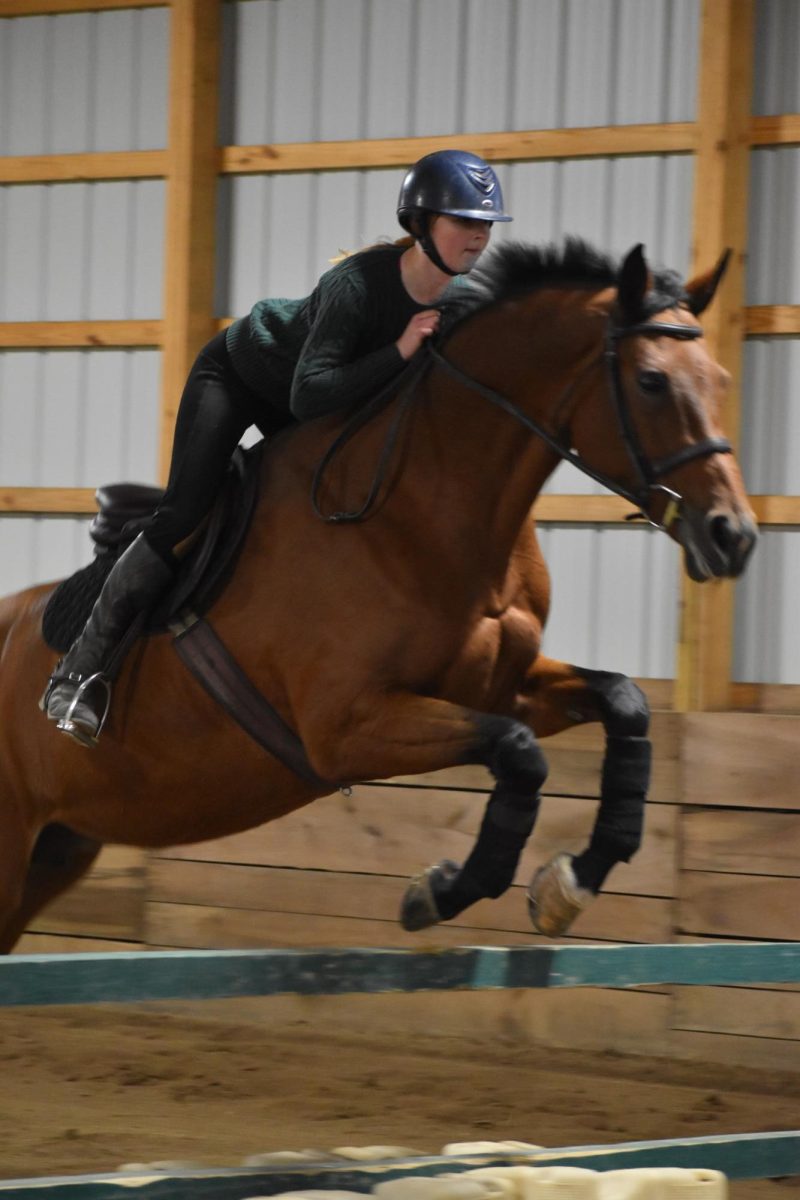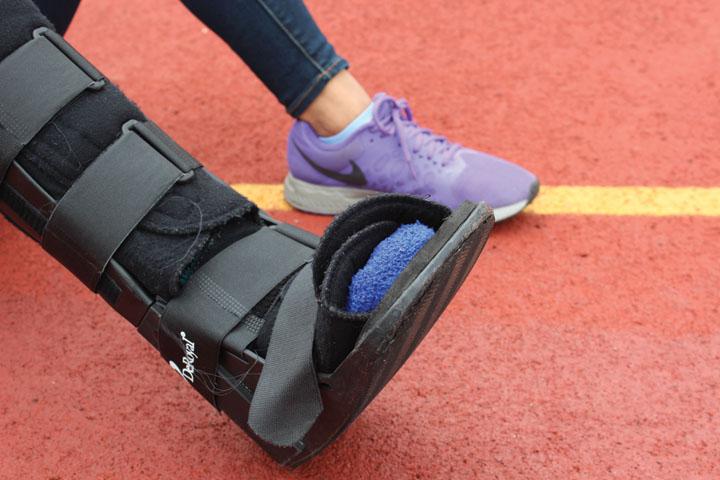Senior Haleigh Overshiner participates in school athletics and said she considers fitness to be an important part of her everyday life, like many CHS students. As a varsity runner on the women’s track team, Overshiner runs five to six days a week and has advanced physical conditioning (APC) classes two to three times a week. Despite the serious time and energy commitments, Overshiner said there are many reasons why she runs.
“It’s always good to be on a team with people,” Overshiner said. “Plus, you look good, you feel good and it’s always good to be in shape. You never know when you need to run.”
As the school year comes to a close, many CHS students may be looking to get in shape for the perfect “summer body.” For some, this may involve new diets or exercise programs. Summer fitness competitions such as those held by the National Physique Committee may further encourage teens to work for an ideal body.
However, there may be some drawbacks to exercising for aesthetic purposes, according to livestrong.com. For example, it may lead excessive exercise habits that can cause increased heart rate, unexplained weight loss and decreased appetite.

According to Mayo Clinic, running, particularly long-distance training, can be one of the more dangerous sports because of its impact on joints. Additionally, chronic training for and participation in extreme endurance events may lead to scarring, enlargement and stiffening of the heart, which increase risks of heart attacks and other heart-related issues.
Overshiner said she recognizes many of these risks but believes exercise, if done safely and in moderation, has many benefits.
“You can get a stress fracture if you exercise too much, or you can be like a lot of people I know who lose a lot of weight from running all the time and they can’t eat enough to maintain a normal body weight,” Overshiner said. “The best way to stay healthy is to just use your best judgement. Whenever I’m injured, in order to make sure I stay healthy and don’t over exercise, I go to the trainer or I tell a coach where the pain is or if I feel any type of fatigue.”
Aaron McRill, head coach of women’s track team, said long-distance running in particular can have health risks, which makes using caution and safety when exercising especially important.
“People (who) go out and run 50-mile races or longer than three hours are putting trauma on their body, so running can be dangerous, but if done right, it can be really healthy,” McRill said. “The safest way to exercise is listening to your body and knowing when your body’s had enough and needs to rest. Nobody knows you like you and you have to be in tune with yourself and know what’s too much for you and what’s not.”
In addition, long-distance running can become addictive. According to a study conducted on rats at Tufts University, the release of endorphins following a workout simulated the effects of opiate use and some rats even exhibited withdrawal symptoms.
“Running can absolutely become addictive. Anything really can. You’ll actually see studies of people that were alcoholics or drug users that come clean and quit using alcohol and drugs, but they need another vice, so a lot of them actually turn to long-distance running,” McRill said.
Despite these risks, school nurse Julie Beihold said there is not much awareness of them.
“In my experience, no, it’s not really out there because there’s some other issues that are probably more prevalent and bigger. I hear more about obesity, on the opposite end of the spectrum,” Beihold said.
Overshiner said, “I don’t think over exercising affects a lot of people, but for the people it affects, it affects them to a greater degree and that needs to be addressed.”
She also said she believes the track coaches do a good job of addressing excessive exercising and making sure athletes exercise safely.
“For the track team, the coaches always take safety into consideration,” Overshiner said. “They never tell an athlete to push themselves too hard.”
Although Overshiner said she believes she exercises a healthy amount now as a senior, she said she used to exercise excessively when she was a sophomore.
“I wanted to be varsity really badly, so after practices, I would go to the gym and I would run an additional 3 miles hard, with rests in between,” she said. “I started getting pain in my leg, and a coach, who doesn’t coach here anymore, told me it was just a shin splint and to keep running. So I kept running and I kept up with those extra miles I was doing until I couldn’t take it anymore. When I finally went to a doctor, they put me in a boot for seven weeks.”
Overshiner said this experience has helped her to realize the importance of exercising intelligently and safely.
Because of situations similar to this, McRill said track coaches take running-related injuries seriously.
“If someone looks tired or someone is struggling, we want to make sure that they’re not overusing the body and pushing themselves too hard because that doesn’t help anyone in the long run,” McRill said. “As track and cross-country coaches, we try to look out for everyone and make sure they’re doing things correctly.”
For body-builder and senior James “Jamie” Dash, safety is a concern that he considers a lot in his workouts. Because of the intensity and frequency of his workouts, which usually consist of six exercises with four sets of eight to 12 repetitions on a daily basis, Dash must take many measures to stay safe and prevent overworking his muscles.
“To a point, there can be too much exercise when it starts infringing on joint issues, but you are able to structure your workout, so you’re not overworking your muscles,” he said. “I’ll stretch beforehand, make sure I have enough nutrients to work out without getting injured and make sure I warm up prior. I also avoid training muscles on the same day, but stagger it so everything has time to recover.”
In addition to following these safety measures, Beihold also recommends that athletes maintain a balance between exercise and rest, in order to prevent injury from repetitive use.
“If exercise becomes so excessive to a point where it begins to crowd out other activities so they are excluding things that would provide a well-rounded life or existence, like friends and social activities and school … If they crowd those things out by overexercising, that is completely unhealthy,” Beihold said.
“Students have a lot of pressure. They have to balanceschool, academics, sports, social (lives) and some of them even have jobs,” Beihold said. “In addition to that, our athletes perform at a high level and they are at higher risk of injury because of the intensity, so they need to follow the guidelines of their coach and trainer and doctor to prevent injury.”

According to McRill, track is especially intense and competitive because of the nature of the sport and the skill level of athletes at CHS.
“Runners are always searching for a faster time or longer distance. The good thing, or the bad thing, if you want to look at it like that, is that you’re never going to beat the clock and you’re never going to be able to run around the world. There’s always a goal in front of you.” McRill said. “People want to be on varsity and get the accolades and be part of a championship team. The negative part is that not all people get to be varsity, not all people get to be on stage for our big win, but I see it all as a positive because if you’re the last runner on that team, I feel that you are still part of that team…Everybody’s important.”
Despite this, Overshiner said her goal of being on the varsity team at a competitive school contributed to unhealthy exercise habits.

“There’s a tremendous pressure to do well in sports, especially with track. It’s more of an independent sport. You don’t rely on other people for how you run,” Overshiner said. “That’s why it can be frustrating if you feel your work isn’t getting you where you want to be on the team.”
Overshiner said although she recognizes the risk of excessive exercise, she said she believes the benefits of exercising far outweigh the drawbacks and will continue to regularly exercise.
“I love running because you get to do it with friends and there’s a social aspect, on top of the exercise you get,” Overshiner said. “Plus, there’s a sense of accomplishment that comes with finishing a good run.”
According to Dash, there are many benefits of exercising that are important to him.
“I exercise because I personally enjoy it and I enjoy how it changes me physically. Exercise and fitness is one of the most important parts of my life,” Dash said. “Not many people get to the point where they would over exercise because most people don’t have the drive to have that problem. And generally the people that have the drive to overexercise have a better knowledge, so they won’t injure themselves.”
McRill said he sees running as more of a fun hobby, rather than a tedious chore.
“I love running. I was good at it when I was younger; it’s kind of an escape for me. I take my runs, and I do a lot of work in my head as I’m running,” McRill said. “People run because it’s social, you make a lot of friends. There’s a billion reasons why you can run.”


































![British royalty are American celebrities [opinion]](https://hilite.org/wp-content/uploads/2024/03/Screenshot-2024-03-24-1.44.57-PM.png)



















![Chelsea Meng on her instagram-run bracelet shop [Biz Buzz]](https://hilite.org/wp-content/uploads/2024/04/IMG_2446-1200x838.jpg)
![Review: Quiet on Set: The Dark Side of Kids TV is the long awaited exposé of pedophilia within the children’s entertainment industry [MUSE]](https://hilite.org/wp-content/uploads/2024/04/unnamed.jpg)
![Review: “The Iron Claw” cannot get enough praise [MUSE]](https://hilite.org/wp-content/uploads/2024/04/unnamed.png)
![Review: “The Bear” sets an unbelievably high bar for future comedy shows [MUSE]](https://hilite.org/wp-content/uploads/2024/03/unnamed.png)
![Review: “Mysterious Lotus Casebook” is an amazing historical Chinese drama [MUSE]](https://hilite.org/wp-content/uploads/2024/03/0.webp)
![Review in Print: Maripaz Villar brings a delightfully unique style to the world of WEBTOON [MUSE]](https://hilite.org/wp-content/uploads/2023/12/maripazcover-1200x960.jpg)
![Review: “The Sword of Kaigen” is a masterpiece [MUSE]](https://hilite.org/wp-content/uploads/2023/11/Screenshot-2023-11-26-201051.png)
![Review: Gateron Oil Kings, great linear switches, okay price [MUSE]](https://hilite.org/wp-content/uploads/2023/11/Screenshot-2023-11-26-200553.png)
![Review: “A Haunting in Venice” is a significant improvement from other Agatha Christie adaptations [MUSE]](https://hilite.org/wp-content/uploads/2023/11/e7ee2938a6d422669771bce6d8088521.jpg)
![Review: A Thanksgiving story from elementary school, still just as interesting [MUSE]](https://hilite.org/wp-content/uploads/2023/11/Screenshot-2023-11-26-195514-987x1200.png)
![Review: When I Fly Towards You, cute, uplifting youth drama [MUSE]](https://hilite.org/wp-content/uploads/2023/09/When-I-Fly-Towards-You-Chinese-drama.png)
![Postcards from Muse: Hawaii Travel Diary [MUSE]](https://hilite.org/wp-content/uploads/2023/09/My-project-1-1200x1200.jpg)
![Review: Ladybug & Cat Noir: The Movie, departure from original show [MUSE]](https://hilite.org/wp-content/uploads/2023/09/Ladybug__Cat_Noir_-_The_Movie_poster.jpg)
![Review in Print: Hidden Love is the cute, uplifting drama everyone needs [MUSE]](https://hilite.org/wp-content/uploads/2023/09/hiddenlovecover-e1693597208225-1030x1200.png)
![Review in Print: Heartstopper is the heartwarming queer romance we all need [MUSE]](https://hilite.org/wp-content/uploads/2023/08/museheartstoppercover-1200x654.png)






















![Review: Ladybug & Cat Noir: The Movie, departure from original show [MUSE]](https://hilite.org/wp-content/uploads/2023/09/Ladybug__Cat_Noir_-_The_Movie_poster-221x300.jpg)

![Review: Next in Fashion season two survives changes, becomes a valuable pop culture artifact [MUSE]](https://hilite.org/wp-content/uploads/2023/03/Screen-Shot-2023-03-09-at-11.05.05-AM-300x214.png)
![Review: Is The Stormlight Archive worth it? [MUSE]](https://hilite.org/wp-content/uploads/2023/10/unnamed-1-184x300.png)




